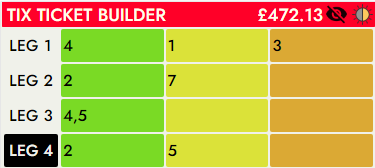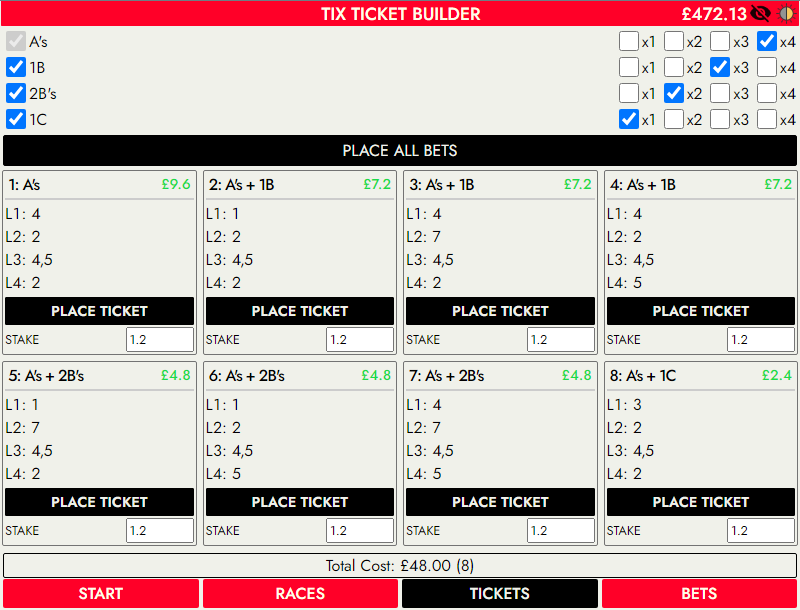In any sequence of races, you will have stronger feelings about some horses than others, and you will consider some outcomes more likely than others based on the odds. It makes no sense, then, to weight all of your selections equally given the unequal sentiment in which you hold them.
For example, say you put a Quadpot perm together as follows (horse numbers, and odds), ignoring the notion of ‘one brave race’ (see Bankers) for the purposes of this scenario:
Leg 1 – 1 (3/1), 3 (8/1), 4 (6/5)
Leg 2 – 2 (2/5), 7 (4/1)
Leg 3 – 4 (2/1), 5 (7/2)
Leg 4 – 2 (Evs), 5 (4/1)
The most basic form of permutation would be 3 x 2 x 2 x 2 = 24 bets. And this is the approach taken by greater than 99% of multi-race players. Indeed, you might be forgiven for thinking, “Well, it’s only 24 bets, at £2 a throw it’s just £48”.
But if you have a winning ticket with odds 6/5, 2/5, 2/1 and Evs on it, you’ll do very well to get your money back. And, according to the market, that’s the most likely outcome.
So how can you better utilize that £48 stake? By using a weighted perm structure, of course. The one I favour, though by no means the only one, is ABCX.
With ABCX, you essentially separate all of the horses in your sequence of races into:
A – main fancies, strong chance
B – fair chance, quite like
C – dark horses, value at the price
X – not interested
Let’s apply that rationale to our initial bet, noting that all horses not selected have been discarded as ‘X’
Leg 1 – 1 (3/1 B), 3 (8/1 C), 4 (6/5 A)
Leg 2 – 2 (2/5 A), 7 (4/1 B)
Leg 3 – 4 (2/1 A), 5 (7/2 A)
Leg 4 – 2 (Evs A), 5 (4/1 B)
Leg 1 has one each of A, B and C; Leg 2 has an A and a B; Leg 3 has two A’s; and Leg 4 has an A and a B.

When using ABCX, we are saying that some combinations of outcomes are more likely than others. Specifically, it is most likely that we will win with all of our A selections; it is next most likely that we will win with three A choices and a B; and it is less likely that we will win with either two A’s and two B’s, or three A’s and a C.
Importantly, we are also saying that if we are sufficiently wrong in our analysis that the result comes back with an A, one or two B’a and a C (or an A and three B’s), we have to accept that we will lose, despite selecting those horses in our initial wide sweep.
This can be a difficult concept to grasp when all four winners appear somewhere in the ticket perm, especially for newcomers; but it is crucial if we are to avoid throwing a large wad of cash at the wall and hoping some of it sticks.
Remember, if you haven’t got at least one strong opinion, you shouldn’t be playing. So, if you snake your way out of a winner by optimizing your staking, wipe your mouth and move on.
Let’s now look at how the original 24 x £2 bet might look using the above ABCX ticket distribution (click the image to open full screen in another tab)

As you can see, we’ve spent the same £48 across five tickets.
Ticket #1 has a unit stake of £4.80 (£1.20 x 4, see All A’s multiplier in the top area of the image) per line, and includes all of the A selections.
Tickets #2, #3 and #4 have a unit stake of £3.60 each per line, and include two A’s and one B each (£1.20 x 3, see 1B multiplier in the top area of the image).
Ticket #5, #6 and #7 have a £2.40 unit stake, and include combinations of two A’s and two B’s (£1.20 x 2, see 2B’s multiplier in the top area of the image).
Ticket #8 has a £1.20 unit stake, and includes the C pick from race 1 with A’ss in races 2, 3 and 4 (£1.20 x 1, see 1C multiplier in the top area of the image).
Now, we have an optimal combination of likelihood of success and multiples of the dividend. In plain English, if the most likely horses win, we’ll have more units of a skinnier dividend, and if some of the less likely horses win we’ll have fewer units of a bigger payoff.
The good news is, as you might have guessed from the image above, the Tix app does all the crunching for you. All you have to do is pick the horses and add them in A, B and/or C slots. The APP button in the menu, or just click here >
